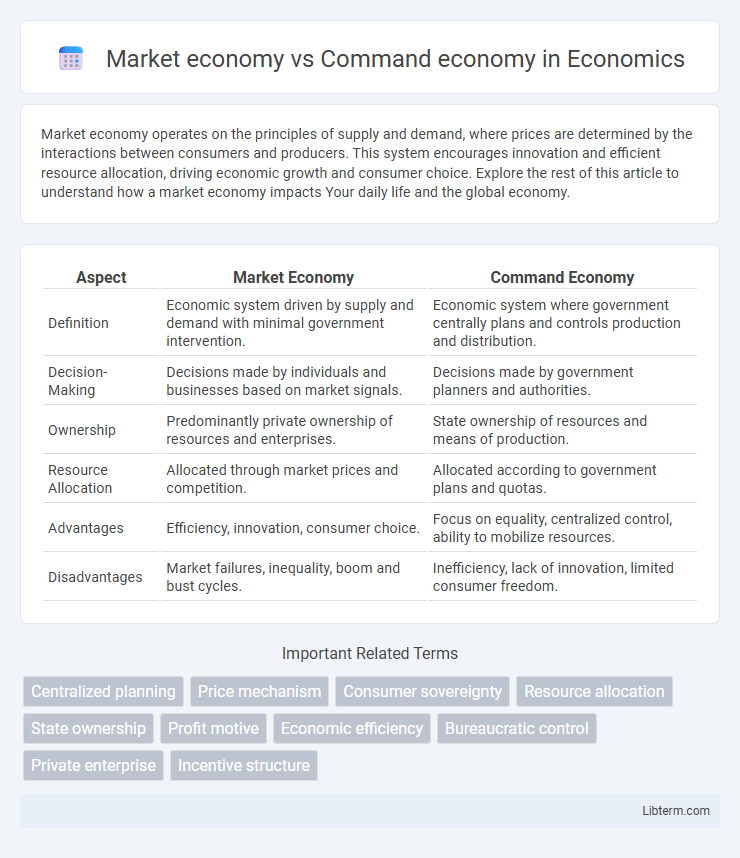Market economy operates on the principles of supply and demand, where prices are determined by the interactions between consumers and producers. This system encourages innovation and efficient resource allocation, driving economic growth and consumer choice. Explore the rest of this article to understand how a market economy impacts Your daily life and the global economy.
Table of Comparison
| Aspect | Market Economy | Command Economy |
|---|---|---|
| Definition | Economic system driven by supply and demand with minimal government intervention. | Economic system where government centrally plans and controls production and distribution. |
| Decision-Making | Decisions made by individuals and businesses based on market signals. | Decisions made by government planners and authorities. |
| Ownership | Predominantly private ownership of resources and enterprises. | State ownership of resources and means of production. |
| Resource Allocation | Allocated through market prices and competition. | Allocated according to government plans and quotas. |
| Advantages | Efficiency, innovation, consumer choice. | Focus on equality, centralized control, ability to mobilize resources. |
| Disadvantages | Market failures, inequality, boom and bust cycles. | Inefficiency, lack of innovation, limited consumer freedom. |
Introduction to Market and Command Economies
Market economies allocate resources through decentralized decisions made by individuals and businesses based on supply, demand, and price signals, fostering competition and innovation. Command economies rely on central governments to control production, distribution, and pricing, aiming to achieve specific economic goals and equitable resource distribution. Understanding the fundamental differences between these systems highlights their impact on economic efficiency, individual freedom, and government intervention.
Defining Market Economy
A market economy is an economic system where supply and demand determine the production and pricing of goods and services, with minimal government intervention. Private ownership and competitive markets drive efficiency and innovation, allocating resources based on consumer preferences. This decentralized approach contrasts with command economies, where central authorities control economic activities.
Defining Command Economy
A command economy is an economic system where the government centrally plans and controls production, distribution, and pricing of goods and services. Unlike market economies, resource allocation is determined by state directives rather than market forces such as supply and demand. Command economies aim to achieve specific social or economic goals through centralized decision-making and often lack private ownership of production means.
Key Features of Market Economies
Market economies prioritize private ownership and decentralized decision-making, where supply and demand determine prices and resource allocation. Key features include competition driving innovation, consumer choice influencing production, and limited government intervention to ensure free-market operations. This system fosters efficiency and entrepreneurship by rewarding businesses that meet consumer needs effectively.
Key Features of Command Economies
Command economies feature centralized government control over production, resource allocation, and pricing decisions, eliminating private ownership of major industries. The state determines economic goals, plans output quantities, and distributes goods and services based on political priorities rather than market demand. This system often results in reduced consumer choice, limited innovation, and inefficiencies due to the absence of competitive market signals.
Role of Government in Both Systems
In a market economy, the government's role is limited to enforcing laws, protecting property rights, and maintaining competition, allowing supply and demand to dictate economic activities. In contrast, a command economy features significant government intervention, with authorities controlling production, pricing, and distribution of goods and services to achieve planned economic objectives. Governmental influence in a command economy aims to allocate resources efficiently according to centralized plans, while a market economy relies on decentralized decision-making by individuals and businesses.
Resource Allocation and Efficiency
Market economies allocate resources through decentralized decision-making by individuals and firms, leading to efficient distribution based on supply, demand, and price signals. Command economies rely on centralized planning by the government to allocate resources, often resulting in inefficiencies due to lack of responsiveness to consumer preferences and resource misallocation. The flexibility of market economies typically drives higher productivity and innovation compared to the rigid structures of command economies.
Consumer Choice and Economic Freedom
Market economies prioritize consumer choice and economic freedom by allowing individuals to make purchasing decisions and entrepreneurs to innovate without heavy government intervention. In contrast, command economies limit consumer choice as the government controls production and distribution, restricting economic freedom. This central planning often results in fewer product options and less responsiveness to consumer preferences compared to market-driven systems.
Advantages and Disadvantages Compared
Market economy promotes efficiency and innovation by allowing supply and demand to dictate production and pricing, facilitating consumer choice and entrepreneurial freedom. However, it can lead to income inequality and market failures without government intervention. Command economy ensures resource allocation based on central planning, potentially reducing unemployment and promoting social welfare but often suffers from inefficiencies, lack of innovation, and limited consumer freedom.
Real-World Examples and Case Studies
Market economies, exemplified by the United States and Germany, thrive on decentralized decision-making, where supply and demand dictate resource allocation, fostering innovation and efficient production. Command economies, such as North Korea and the former Soviet Union, rely on centralized government control to manage economic activities, often resulting in inefficiencies and limited consumer choice. Case studies of China's gradual shift from a command to a mixed market economy highlight significant economic growth driven by market-oriented reforms coupled with state oversight.
Market economy Infographic

 libterm.com
libterm.com